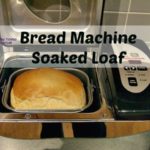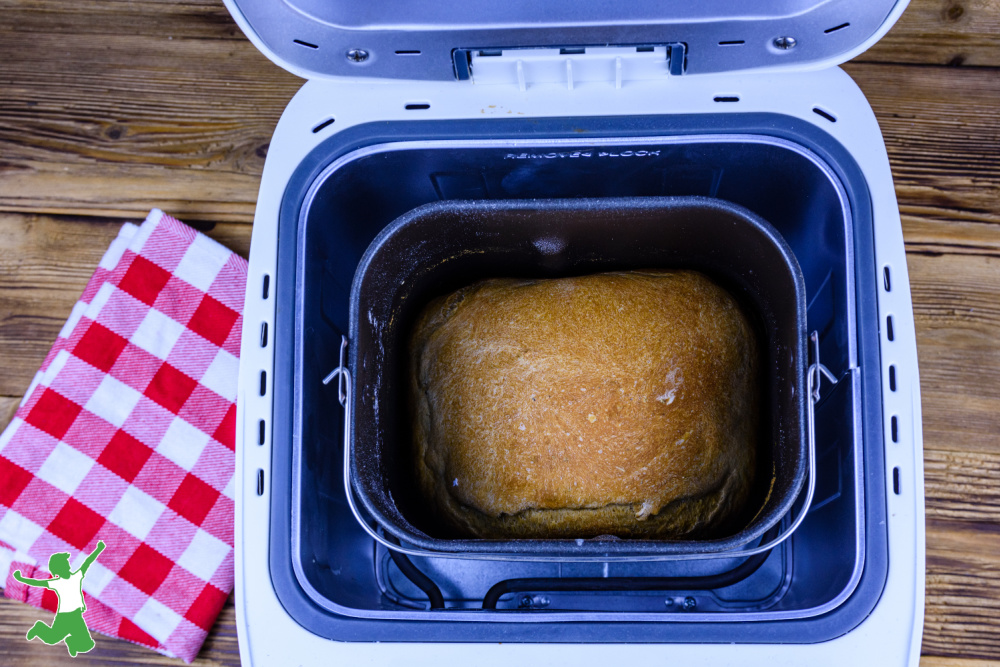Table of Contents[Hide][Show]
A handy bread machine recipe for a delicious, conveniently made loaf using soaked flour for much improved nutrition and digestibility.
Homemade bread is making a comeback! The convenience of using a bread machine recipe is part of the reason why as more and more people opt to make their own with quality ingredients they source themselves.
Quality over convenience is an idea whose time has come in the bread department. The general public is awakening to the dangers of white flour, one of the “displacing foods of modern commerce” as described by Dr. Weston A. Price in his nutritional classic Nutrition and Physical Degeneration.
This is a radical change from even just a few decades ago.
My Grandmother, like many of her generation, always chose white bread over “brown bread” as she called it. She considered whole wheat bread a sign of poverty because she observed growing up that those who ate white bread were more affluent and educated.
Fortunately, this notion is no longer a popular mindset.
Whole Grain Homemade Bread is Best
Not only is bread made with white flour basically devoid of nutrition, but it also adds to the body’s toxic load with a plethora of additives, chemicals, and unhealthy vegetable oils.
Worse, unlike the white bread even just 10 years ago, store bread frequently contains soy flour. This modern food threatens hormonal health and can trigger digestive problems for those who are sensitive.
Even commercially made sprouted bread masquerading as healthy frequently contains seitan or vital wheat gluten. This additive is nearly impossible to digest when isolated for use by food manufacturers.
Consumers choosing to bake their own bread usually forgo white flour in favor of whole wheat or other whole grains. Popular examples include teff or millet.
While whole grain flour may be fresher when you grind it at home and the bread more nutritious, other problems can emerge.
Modern breadmaking using a bread machine recipe typically employs the use of yeast and high heat. This quickly raises the dough and bakes the bread in a short amount of time.
This contrasts with the slow, natural rise that occurs with fermented dough baked at a lower temperature.
Why Use Soaked Flour?
Science has demonstrated the wisdom of the careful preparation methods of our ancestors. All grains and legumes contain phytic acid, an organic acid that blocks mineral absorption in the intestinal tract.
Powerful anti-nutrients in grain flour are neutralized in as little as 7 hours of soaking in water with small amounts of an acidic medium.
Examples include yogurt, kefir, lemon juice or cider vinegar. Soaking also neutralizes enzyme inhibitors present in the hulls of all grains and adds beneficial enzymes that increase the amount of nutrients present – especially the B vitamins.
For those with gluten intolerance, soaking or fermenting gluten-based grains breaks down this difficult-to-digest plant protein; studies carried out in Italy have found that people with celiac disease can consume genuine sourdough bread without digestive distress or auto-immune symptoms.
I frequently get asked how to make fresh bread at home using the traditional method of soaking flour first combined with the modern convenience of a bread machine.
If you have a breadmaker and would like to transition to a traditional method for making bread while continuing to use this appliance, here’s a bread machine recipe to try.
It is adapted from Healthy4Life by the Weston A. Price Foundation.
Enjoy your fresh-baked loaf courtesy of a blend of modern convenience and Traditional Wisdom!

Bread Machine Recipe using Soaked Flour
A handy bread machine recipe for a delicious conveniently made loaf using the traditional preparation method of soaking flour for much-improved nutrition and digestibility.
Ingredients
- 10 Tbl whole yogurt
- 3/4 cup filtered water
- 4 cups whole grain flour less 3 Tbl, preferably freshly ground
- 2 Tbl butter softened
- 1 Tbl molasses
- 3 Tbl arrowroot powder
- 1 3/4 tsp dried yeast
- 1 tsp sea salt
Instructions
-
Mix yogurt with water and mix with the flour to form a dough. Cover and leave in a warm spot on the kitchen counter for 18-24 hours.
-
When it is partway through the kneading section, check that all the ingredients have mixed together and observe the consistency of the dough.
-
If it is slimy, add some more arrowroot powder. If it’s too dry, add a few more drops of water, drop by drop.
-
Proceed as directed for your particular bread machine model to finish baking your traditional loaf!
Once you’ve made your soaked loaf, be sure to save the crusts because they are perfect for making breadcrumbs!
More Traditional Bread Recipes
Interested in traditional breadmaking? Try these other recipes inspired by ancestral wisdom.









Can’t wait to try.
I would like to try this with my kitchen aid mixer and conventional oven – as I don’t have a bread machine and don’t care to. will this recipe work?
I use my bosch to mix the flour and yogurt together and leave it in over night. Then I add the other ingredients, mix. Sometimes I have to add water but I am very careful not to over do it. Roll out into loaves, let rise and bake. It works wonderfully. I don’t have a bread machine.
Thank you so much Terri! I’d love to try this recipe. Now I can. 🙂
Terri- I would like to do this in my oven- but what temperature and how long would the bread need to be baked? Any idea?
I cook it at 350 for 30 to 35 minutes. It is a very easy recipe and makes light wonderful loaves.
Thanks, Terri, I’m glad I found your response, this looks very interesting and I am eager to try it!
Thank you Terri, your responses were exactly what I was looking for also! I don’t want to use the bread machines and their non-stick coatings so the oven method was just what I needed. Thank you kindly!!!
Thanks for the information on baking in an oven. Can’t wait to try this recipe as well!
How long do you mix it on the Bosch and what speed? I have a Universal.
Hey Sarah!
My In-Laws have given me a couple 5# cans of Turkey Red Hard Winter Wheat (from Utah…really old stuff!)
Wondering if you have any recipes that would work with that, and also wondering if I need to soak them before doing anything. I’m soaking illiterate as of right now but really want to try the wheat out!
Thanks!
What kind of bread machine is this? I have heard most bread machines can’t handle 100% whole wheat. I’d love one that could!!
The machine in the photo is a Morphy Richards. Fabulous brand. I can’t get them here in NZ and have been using my mothers which has a whole wheat function (can’t even see a brand marked on there – must be a cheap one!). I’ve been using this recipe for ages – it’s really easy and yummy.
I can’t find this one online. I found the company but not that breadmaker. Any other recommendations?
I have not started sourdough baking but it is at the top of my list. Now I am confused. The celiac blog post/link above you write “Abandoning the traditional methods of bread preparation in favor of baker’s yeast would have disastrous effects on people’s health.”
So is baker’s yeast good for you or bad?
Thank you for further elaboration.
Diane
Baker’s yeast is not in and of itself bad … it is only bad when it is used in place of traditional preparation methods. In this recipe, you use a bit to assist with the rising in the bread machine but the bread is already properly soaked for a period of time to ensure deactivation of anti-nutrients.
This is really interesting and indeed helpful. I occasionally bake bread, not as often as I could, but have neglected using the bread machine just because I didn’t really see a way to make a healthier loaf that didn’t come out like a bowling ball! I can’t wait to try this. Thank you for the excellent information.
How great! Could you use kefir (with some whey strained out to make it thicker) instead of the yogurt?
Yes, absolutely.
Sarah, have a question… if you sprout your wheat do you also need to soak it?
No you don’t need to soak if you use sprouted flour. I do know a few folks who do both as they say they digest it better with both methods used together.
If the flour is fermented, why do you need to add yeast? Also, can this recipe be baked in an oven?
Mona, the yogurt bacteria helps to break down anti-nutrients in the flour, but it doesn’t leaven it like a sourdough starter would. So the soaked flour will just be a pasty glob after the 18-24 hours, not a risen loaf like with a sourdough. I am planning to attempt this recipe in an oven and see how it goes!
Thanks, let me know how it turns out 🙂
I’m new to traditional cooking methods so still trying to get acquainted with it all. What’s in a sourdough starter?
im doing in my kitchin aid and over. I used for a Jordan Rubin muffin recipe..carrots culture instead of yogurt. worked good. sure could have used lemon or cider vinegar but yogurt has probiotics too so tried it.
we make all our bread including sourdough. I wanted to know if I can use organic sage honey in place of the molasses?
And what roll does arrowroot play in this recipe?
Thanks.
When you soak flour, it breaks down the gluten which makes the bread much more delicate in texture … the arrowroot adds a bit of firmness to the loaf.